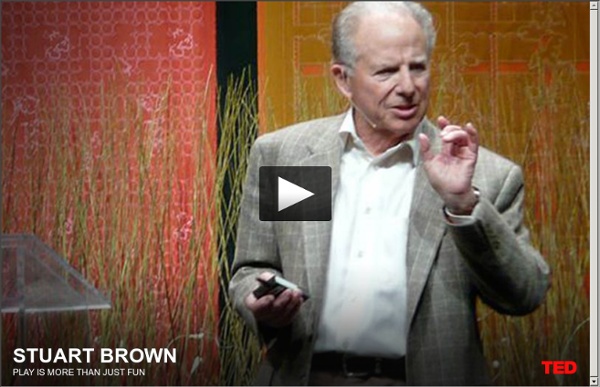



http://www.ted.com/talks/stuart_brown_says_play_is_more_than_fun_it_s_vital.html
What Do Babies Think? Part 3 of the TED Radio Hour episode Unstoppable Learning. About Alison Gopnik's TEDTalk Alison Gopnik's research explores the sophisticated intelligence-gathering and decision-making that babies are doing when they play. She offers a glimpse into the minds of babies and young children, to show how much and how fast they learn. About Alison Gopnik 10 great TED Talks about talking Science The language of dolphins: Denise Herzing at TED2013 A dolphin’s brain-to-body-weight ratio is second only to a human’s. They live complex social lives, can understand abstract concepts and even use tools.
Experiences Build Brain Architecture The basic architecture of the brain is constructed through a process that begins early in life and continues into adulthood. Simpler circuits come first and more complex brain circuits build on them later. Genes provide the basic blueprint, but experiences influence how or whether genes are expressed. Together, they shape the quality of brain architecture and establish either a sturdy or a fragile foundation for all of the learning, health, and behavior that follow. Plasticity, or the ability for the brain to reorganize and adapt, is greatest in the first years of life and decreases with age. InBrief: The Science of Early Childhood Development (Video) Search InBrief: The Science of Early Childhood Development This edition of the InBrief series addresses basic concepts of early childhood development, established over decades of neuroscience and behavioral research, which help illustrate why child development—particularly from birth to five years—is a foundation for a prosperous and sustainable society. View this video en Español >> Download PDF version of this InBrief >>
How Smart Can We Get? How Smart Can We Get? PBS Airdate: October 24, 2012 DAVID POGUE (Host): How smart are you? MEMORY CHAMPIONSHIP ANNOUNCER: Mental athletes, begin. DAVID POGUE: Would you like to be smarter? I feel like increasing my cortical tissue. PDQ Blog An inside look at some of the top teacher prep programs Today NCTQ released its Teacher Prep Review, which takes a close look at the quality of training provided by 2,420 teacher preparation programs across the country. Our results show that most have a long way to go to get teachers classroom ready from day one. But there are some programs that stand out. To paint a picture of what strong teacher prep can look like, we've created short videos on some of the programs that excel overall (Lipscomb University, Ohio State) or in particular areas (Louisiana State in elementary math, Arizona State in student teaching, and Morgan State in elementary and secondary content). It's programs like these that aspiring teachers should strongly think about applying to and that districts should look to recruit from.
Mapping Brain Connectivity The new field of “connectomics” aims to show how brains behave at a level not previously possible—examining how entire brains are wired together, how wiring changes as brains grow up, and how interactions with the external world affect this wiring. The Lichtman Lab at Harvard University, a partner in the Conte Center at Harvard, pioneered tools to potentially map every connection in a complete brain and has started to map the connectome in mouse brains. In this narrated, 15-minute multimedia presentation, postdoctoral fellow Bobby Kasthuri shares some of the results and insights from his work at the Lichtman Lab, using images and videos that show three-dimensional recreations of actual neural connections in the brain. He also discusses the future direction of this work in helping to understand how early adverse experiences affect connectivity.
Math Play Research Research Clips The Relationship of Teacher-Child Interactions in Preschool Play to Young Children's Mathematical Abilities View a transcript of this video. Want to view this video on an iPod or iPad? Download it from iTunes U. Feminist Frequency Content Warning: This educational episode contains graphic sexual and violent game footage. In this episode we explore the Women as Background Decoration trope which is the subset of largely insignificant non-playable female characters whose sexuality or victimhood is exploited as a way to infuse edgy, gritty or racy flavoring into game worlds. These sexually objectified female bodies are designed to function as environmental texture while titillating presumed straight male players.
How to Show Kids You Care Over the years, Search Institute has sold more than six million copies of 150 Ways to Show Kids You Care, a simple yet powerful poster. Like all of Search Institute’s work, the poster translates scientific research into simple, actionable ways that adults can make a positive difference in young people’s lives. A Search Institute team recently visited the Woodson Kindergarten Center in Austin, Minnesota, where the students helped us re-imagine the ideas on the poster. If you could use a quick reminder of why caring for young people is always worth your time, click here to meet the kindergarteners:
This TED Talk is about play and how it effects the emotional development of a child. As we look at play and how it affects our life we have seen that without play, our life is dull and with play we can grow and experience life to the fullest. We each have a different way that we approach play. Some people play with their speech via flirtation and puns and jokes. Some people play physically via sports and other people play emotionally and cognitively. I had trouble finding where to place this pearl because really it could fit into all of the category but I posted it in the emotional section and then under the subtitle of Pre-K-4th because I think that we all forget about play. Now we are getting better at including it and allowing it to become integrated with our teaching. Dr. Stuart Brown suggests that we couple it with the science of teaching. Don’t set aside time to play but incorporate it into the lessons. by behenderson Feb 26